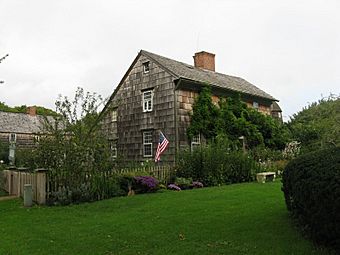East Hampton Village District facts for kids
Quick facts for kids |
|
|
East Hampton Village District
|
|

"Home Sweet Home"
|
|
| Location | Bounded by Main St. and James and Woods Lanes, (original) Northeastward along Main St. to Newton La. and Southwestward along Ocean and Lee Aves. and Pond La. to Hedges La., (increase), East Hampton, New York |
|---|---|
| Architect | J.C. Thorp |
| Architectural style | Late 19th And 20th Century Revivals, Bungalow/Craftsman, Late Victorian |
| MPS | Village of East Hampton MRA |
| NRHP reference No. | 74001309 (original) 88001032 (increase) |
| Added to NRHP | May 2, 1974 (original) July 21, 1988 (increase) |
The East Hampton Village District is a special area in East Hampton, New York. It's known for its important historical buildings and places. This district is officially recognized as a historic district.
It was first added to the National Register of Historic Places in 1974. Later, in 1988, the district was made even larger to include more historic spots.
Contents
Exploring the Historic Village
This historic district is like a living museum. It includes many old buildings and landmarks that tell stories about the past. You can find homes, windmills, and even an old cemetery here.
Famous Homes and Landmarks
Several important buildings are part of this district. One is the John Howard Payne House, also known as "Home Sweet Home." This house is famous because it's linked to the writer of the song "Home Sweet Home."
Another key building is the Thomas Moran House. This house belonged to a famous artist, Thomas Moran. It's so important that it's also a National Historic Landmark.
Old Windmills and Their History
The district also features two old windmills. These are the Pantigo Windmill and the Gardiner Mill. They are examples of New England-style smock windmills. These windmills were once very important for grinding grain.
The Village Green and Cemetery
At the heart of the district is the village green. Next to a flagpole from 1926, there's a large rock with a plaque. This plaque marks the historic district.
The green gently slopes up to the South End Cemetery. This cemetery was once the location of the historic Town Church. The original church had a thatched roof but was later taken down.
Near where the church stood, there's a memorial to Lion Gardiner. His grave is just a short distance away. You can find historical markers about the church on James Lane and Pondview Lane.
The Town Pond
Further along, you'll find the town pond. This oval-shaped pond and the area around it made up the original historic district. It's a peaceful spot that has been part of the village for a very long time.
Expanding the Historic Area
The historic district grew to include more important places. On the other side of James Lane, you can find several other historic buildings.
More Historic Buildings
These include the Tuthill House and the Mulford Farmhouse. The Mulford Farmhouse is a great example of an old colonial farm.
The famous Home Sweet Home house is also in this expanded area. Nearby are St. Luke's Episcopal Church and Rectory. These buildings show the religious history of the village.
Gardiner Mill and Other Markers
The replica of the John Lyon Gardiner Mill Cottage and the Gardiner Mill are also part of the expanded district. You can also see a historical marker for Reverend Thomas James. He was the first pastor of the town church, serving from 1661 to 1692.
The trees along the street near the Mulford homestead are special. Each one has a stone marker with a name and date shield. This shows how much the community values its history and nature.
Images for kids






































